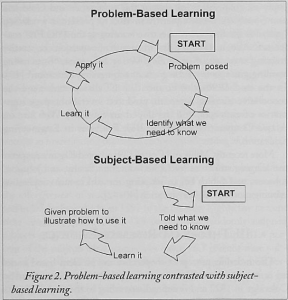Are your students’ learning styles compatible with your teaching style? “To teach is to engage students in learning.” Quote, from Education for Judgment by Christensen et al, [1]. For engineering faculty, the real challenge is not covering the material, but making sure students understand the material. It’s important to know that while presenting your content to your students, there must be time set aside for student to reflect on that content. This creates an opportunity to incorporate student-to-student engagement, Also known as, cooperative learning. “This is an instructional model that allows for small groups of students to work together to maximize thelr learning. Student need to engage with the content incorporating instructional methods such as peer discussions, small team problem-based learning as illustrated by Woods [2], who contrasted it with subject-based learning (Figure 2).
“Breaking up lectures with short cooperative processing times results in slightly less lecture time, but re-engages the students. During lecturing and direct teaching, the instructor ensures that students do the intellectual work of organizing material, explaining it, summarizing it, and integrating it into existing conceptual networks. Common information cooperative learning techniques include “focused discussions” before and after the lecture (bookends) and interspersing turn-to-your-partner discussions throughout the lecture.” (Smith, Sheppard, Johnson, D, Johnson, R, 2005).
Read More http://www.shsu.edu/academics/cce/documents/Pedagogies_of_engagement_Classroom-based_practices.pdf
Resources:
[1] Christensen, C.R,, Garvin, D,A,, and Sweet, A,, Education for
Judgment: Tbe Artistry of Discussion Leadership, Cambridge, Mass.: Harvard
Business School, 1991.
[2] Woods, D.R., Problem-Based Learning: How to Gain the Most from
PBL, Waterdown, Ontario: Donald R, Woods, 1994.
